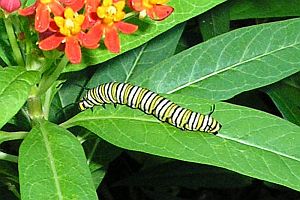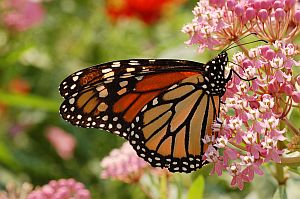Michoacán, Mexico - The dismal state of the Monarch butterfly migration came into closer focus this week, as reports from Mexico suggest that only three million butterflies have arrived at the ancestral roosts in Michoacán.
The 2012 season, acknowledged as the worst year for the insects population wise, counted 60 million Monarchs. In prime years, they numbered 450 million.
Dr. Chip Taylor, founder of Monarch Watch, relayed a similar prognosis two weeks ago, addressing the International Butterfly Breeders conference.
Dr. Taylor stated that the butterflies would likely occupy only 1.25 acres of forest in the mountainous roosting grounds west of Mexico City. At their height, the creatures roosted in 50+ acres of forest. How depressing that the entire population of Monarch butterflies east of the Rocky Mountains could fit into a space smaller than a strip shopping center.
 |
Each December, scientists measure the number of acres occupied by the migrating butterflies at their ancestral wintering sites in the mountains of Michoacán to determine the size of their population.
Our friend and Monarch butterfly expert Dr. Lincoln Brower, quoted in the New York Times, forwarded an email from Mexico to the D-PLEX list (an email list for butterfly enthusiasts) last week.
"What I find worrisome is the late arrival of the butterflies," wrote Dr. Brower, adding that the butterflies usually arrive in force at the very beginning of November. Concern resulted when for the first time in recorded history, the Monarchs did not arrive in time for "Day of the Dead" celebrations in Mexico.
Here’s an excerpt from the email:
"The monarch population is very low, the trees are not fully covered by monarch like in past years. In Chincua, there are approximately 14 trees, in Rosario, a similar number of trees was found. However, in the past few days there was a cold front that entered the country, there were trees that fell down as a result of the strong winds, especially in Rosario, right in the middle of the monarch colony. The colony at Pelon is still wandering about and also with very low numbers."
Biologist Gloria Tavera Alonso told the Spanish language news agency EFE that "More or less we’re estimating that we’ll have 50 percent fewer than this time last year." Last year, only 60 million butterflies made it to the roosting sites, the worst year in history–until now.
What can you do? We’ve suggested in the past that you plant milkweed. That’s a start.
But we also need to encourage our lawmakers to approve the Save America’s Pollinators Act - H.R. 2692. The bill would ban neonicotinoid pesticides, introduced three decades ago without appropriate field study to its side effects.
The newcomer pesticide, often referred to as the "new DDT," is the first new class of pesticides introduced in the last 50 years and, while apparently milder on human beings, has a devastating effect on bees, butterflies, and other pollinators.
 |
Here’s a few facts from the Xerces Society, a pollinator advocacy organization:
• Neonicotinoid residues are found in pollen and nectar consumed by pollinators such as bees and butterflies. The residues can reach lethal concentrations in some situations.
• Neonicotinoids can persist in soil for months or years after a single application. Measurable amounts of residues have been found in woody plants up to six years after it was applied.
• Untreated plants may absorb chemical residues left over in the soil from the previous year.
• Products approved for homeowners to use in gardens, lawns, and on ornamental trees, have manufacturer-recommended application rates up to 120 times higher than rates approved for agricultural crops.
Recent research suggests that neonicotinoids can cause increased levels of proteins in bees that inhibit key molecules involved in their immune response - making the insects more susceptible to attack by harmful viruses. The much publicized Colony Collapse Disorder, which has decimated the bee population, has also been linked to neonicotinoids.
Insects like bees and butterflies are responsible for pollinating 75 percent of our food crops – one of every three bites of food you take. Shortages of bees have increased the cost of growing food because farmers must rent them for pollination services, resulting in food cost production increases by as much as 20 percent.
Please help protect bees, butterflies and other important pollinators by supporting H.R. 2692, the Save America’s Pollinators Act. They are the glue that binds our ecosystem. Sign the petition now.
And in the meantime, plant some milkweed.
Original Story


